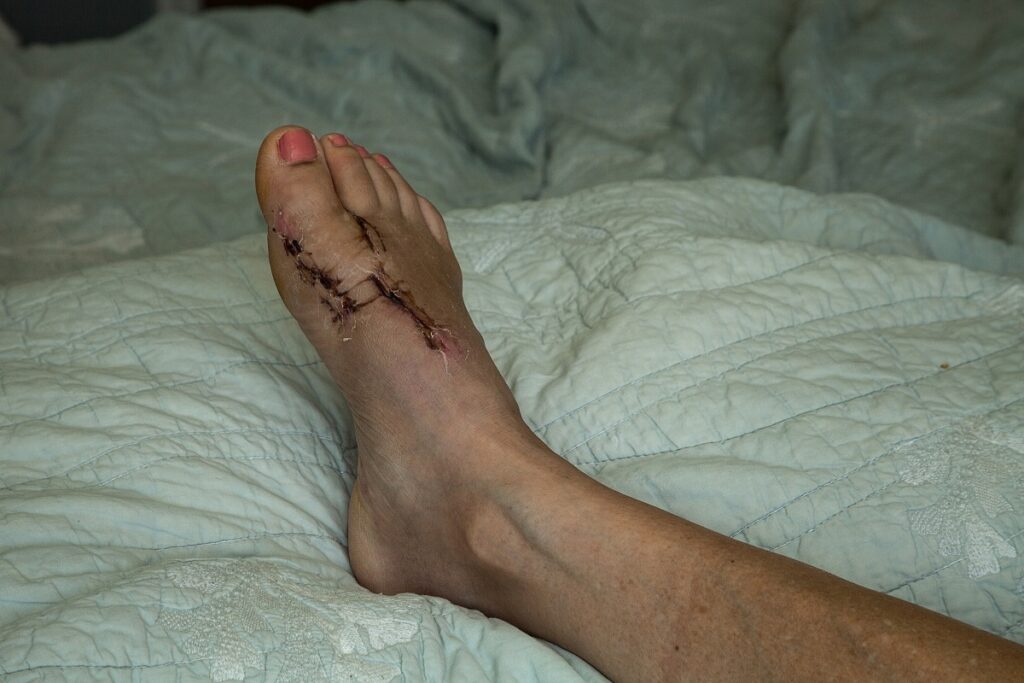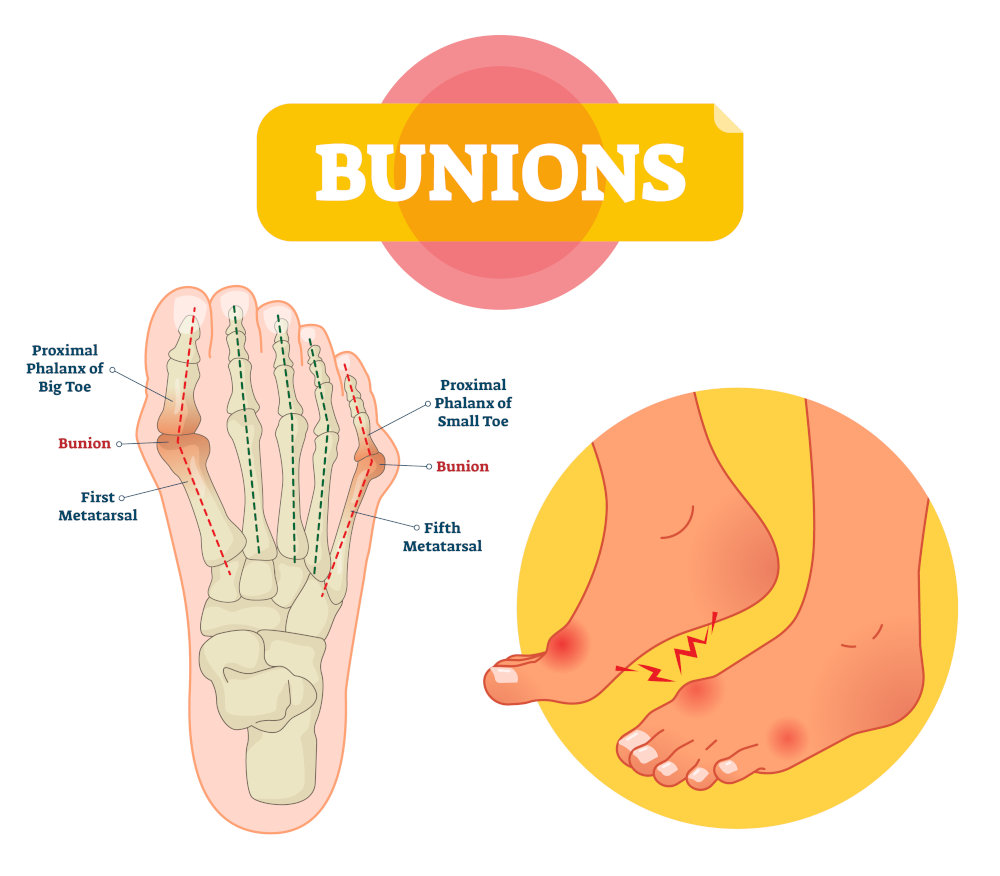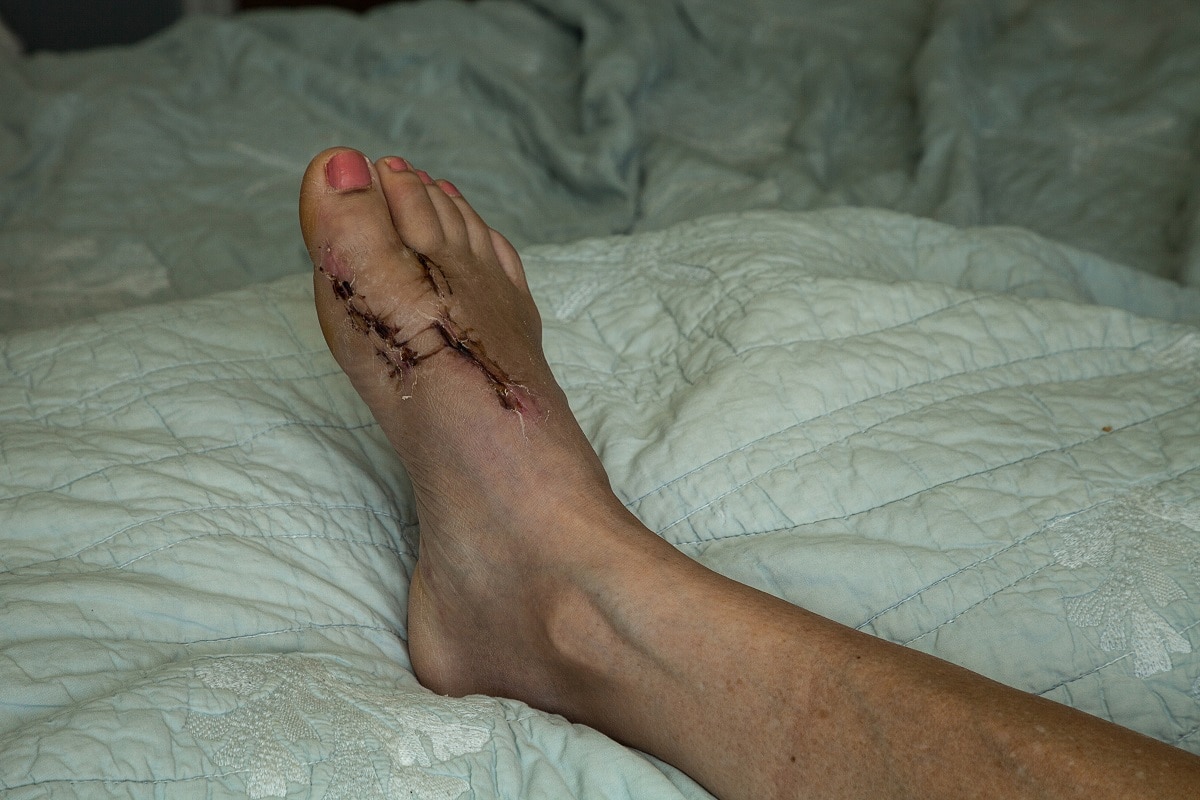
Bunions are a deformity of the big toe joint that can make it difficult and painful to wear shoes. This affliction may be addressed by doing a bunion surgery lapiplasty correction when conservative options fail. If you’re noticing a bump on the inside of your big toe joint that is bothering you when you wear fashionable shoes – this blog is for you.
What is a Bunion?
A bunion deformity is caused by a misalignment of the bones in the foot. The first toe will angulate towards the second toe and the first metatarsal will angulate away from the second metatarsal.
Normally, the first and second metatarsal bones should be close to parallel to each other. However, with a bunion deformity, the angle between the two is increased. This will give the appearance of a large bump on the inside of your big toe joint. The actual bump can be from extra bone on the inside of what is referred to as the metatarsal head but more accurately the primary cause of the prominence is the angle between the metatarsal bones.
What is the goal of surgery?
The goal of surgery is to correct the angle between the first and second metatarsal bones. This correction brings the angle back to a normal anatomical alignment. We do this in such a way that there is no recurrence.
The History of Bunion Correction Procedures
Decades ago, many patients who had bunion surgery had the bump removed. They would use the soft tissue around the great toe joint to realign the toe. These procedures made for an easy recovery but resulted in minimal reduction of deformity and a very high recurrence rate.

Metatarsal Osteotomies
Next, foot and ankle surgeons started to do procedures with osteotomies on the first metatarsal bone to correct the deformity and remove the bump. An osteotomy means that the bone is cut and realigned or shifted to correct the angulation. There were two types of osteotomies; those performed at the metatarsal head (Austin or chevron) in order for the metatarsal head to be shifted. Otherwise, the osteotomies are performed at the base of the metatarsal bone. Those done at the base were for more severe bunions. These types of procedures involved significantly more lay up time. Whether the correction of the deformity is performed at the metatarsal head or the metatarsal base, they are considered traditional bunion surgery.
Next, surgeons determined that maybe the best surgical option was to fuse the first metatarsal cuneiform joint because this is considered an unstable joint. This is called the Lapidus procedure. It corrects the misalignment with a joint fusion. This can work very well but it includes a long lay time. Patients are not allowed to put weight on their foot for at least six weeks non weight bearing. There was also a risk of nonunion or delayed union of bone at the fusion site.
Bunion Surgery Lapiplasty
The bunion surgery lapiplasty procedure is a refinement of the Lapidus procedure. It is promoted as correcting the deformity in three different planes. The procedure also secures the unstable foundation which is believed to be the first metatarsal cuneiform joint. It also allows for early weight bearing. However, it is recommended that you be in a Cam walker so the bones are fully healed for at least six weeks. It is also promoted as having minimal recurrence rate. There are also claims that doing osteotomies of the metatarsal head have very high recurrence rates. Lapiplasty is promoted as having advanced fixation technology to fuse the joint. This technique uses titanium plating technology and these anatomically shaped titanium plates remain in the foot after surgery. Lastly, specialized instrumentation to make the results more precise and predictable are used.
Dr. Anderson’s Opinion of Bunion Surgery Lapiplasty
First, understand that I’ve been curious about this procedure but yet have not performed this procedure.
Here are some notes:
Recurrence Rates: In the marketing material for the Lapiplasty, they suggest a very high recurrence rate for patients that have an osteotomy of the metatarsal head. As a surgeon that has been doing bunion surgeries for 4 decades, I differ with this. Very seldom do we see recurrences. If surgeons were more like me, we would not have continued with these techniques.
They suggest that the correction is more precise because the bunion is being corrected in three planes and not two. In regards to this, yes, I can definitely agree with this; however, one would then assume that if the correction is not done in this manner, less correction was made, and recurrence rates were high – and on this I disagree.
With the Lapiplasty procedure, it is suggested that you will have less layup time. You’ll be able to bear weight within days and will ambulate in a Cam walker for 6 weeks. I’m not sure where the narrative comes from but most patients’ assumption of how long they are laid up is significantly more than the reality. The current way that we do most of our bunion corrections is a few days of non-weight bearing, then walking in a surgical boot or surgery shoe for up to 3-4 weeks. Patients can return to regular shoes in 3-4 weeks. Therefore the conventional approach to bunion surgery using a metatarsal head osteotomy is significantly less than the bunion surgery lapiplasty.
X-Rays of bunion surgery lapiplasty

X-Rays of Anderson Podiatry Center Technique

- Majority of patients opt for our procedure due to successful outcomes
- No pins left in the foot
- Minimal chance of recurrence
- You are back to wearing shoes faster
Hardware Complications: Currently we use small pins to fixate your bone with our bunion corrections. The advantage is that they are removed just weeks after, through a very small incision. Therefore, you don’t need to worry about potential pain from bone screws or plates that remain in your foot.
Marketing for Doctors: in the competitive medical world doctors are sometimes looking for an approach that sets them apart or allows them to market themselves. I have no problem with this but if you’re considering this procedure, please understand that there is motivation to do this procedure because the company that makes the instrument is marketing the doctors. You do the procedure and we will market your practice for you to generate more patients. Please consider this.
My Conclusion
I think the Lapiplasty bunion correction is a welcome addition for how foot and ankle surgeons correct a bunion. I don’t think it should be a one size fits all to be done on all bunions. I also think that it’s misleading to think that this procedure will lay you up less, as with many current approaches you may be back in shoes in 3-4 weeks, not 6 weeks. Many patients don’t know enough about bunion surgery to understand that indeed their bunion deformity may not require the procedures that require longer lay ups. In fact, the majority do not. I can agree that the technique used may lead to more consistent results, that’s assuming the conventional approaches have a lot of variation in outcomes. To summarize, you need to question the recurrence rates that they claim with conventional surgeries, and if it is worth the longer lay up times. If you are considering bunion correction please don’t hesitate to contact us for an initial bunion foot evaluation.
We have local foot clinics in the Fort Collins and Broomfield area with certified podiatrist who are experienced in bunion corrections. Watch out patient testimonial below to hear about the success, Phyllis is just one of many we have treated over the years.
For a full list of videos view our Bunion You Tube playlist.



